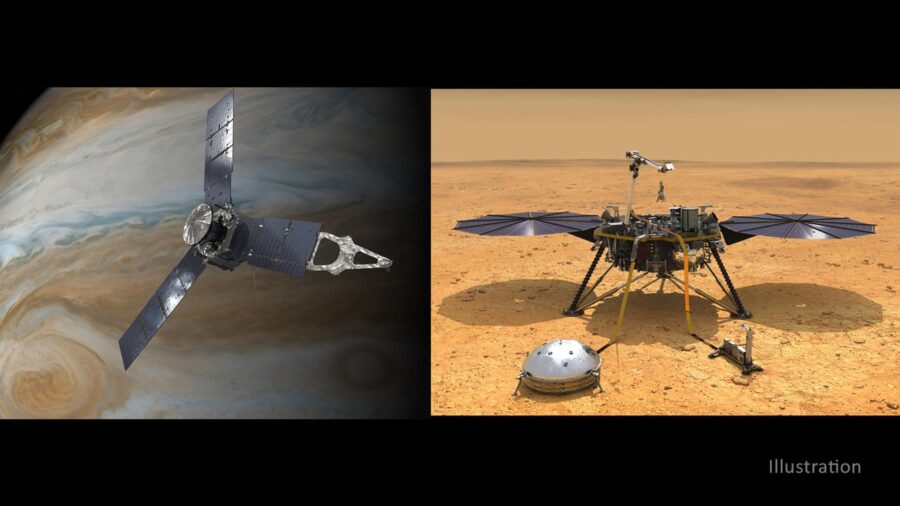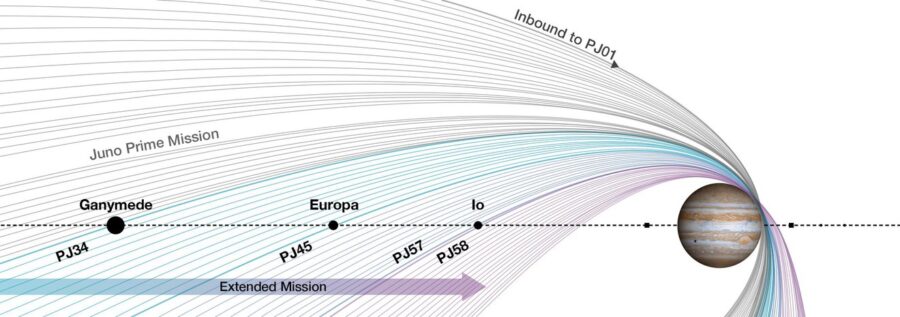NASA has granted two key planetary missions extensions, so InSight and Juno will continue to return data from Mars and Jupiter, respectively, for years to come.

NASA / JPL-Caltech
Once a mission is on-site and operating, it typically makes sense to keep it going. That’s what NASA recently announced it plans to do, granting mission extensions to the Juno orbiter around Jupiter and the InSight lander on Mars.
The Mars InSight Extension
NASA extended the Interior Exploration using Seismic Investigations, Geodesy and Heat Transport (InSight) mission until the end of next year, into December 2022. Originally slated for a 728-day primary mission, InSight landed at Elysium Planitia on November 26, 2018. During that time, the lander has recorded the faint rumblings of more than 480 marsquakes and documented land tides due to the passage of the Martian moon Phobos in an effort to probe the planet's interior structure. InSight also continues to make meteorological observations of the Martian weather, which will in turn complement measurements from the Perseverance rover, slated to land in Jezero Crater on February 18, 2021.
Unfortunately, one of InSight's instruments faced insurmountable difficulty. Efforts to save the heat probe, aka "the Mole," have come to an official end. Part of the HP3 Heat Flow and Physical Properties Package provided by the German Aerospace Center (DLR), the plan was for the Mole to hammer to a minimum depth of 3 meters and take measurements of the heat flow from the Martian interior.
However, the composition of the soil at the landing site appears to be more compact than what previous missions, such as Viking 1 and 2 and Mars Phoenix, encountered. Controllers tried many techniques, including pushing on the mole with the scoop arm in an attempt to gain traction, but to no avail. The top of the Mole had made it 2 to 3 centimeters beneath the surface when efforts ended.

NASA / JPL-Caltech
“We’ve given it everything we’ve got, but Mars and our heroic mole remain incompatible,” said HP3 principal investigator Tilman Spohn (DLR and International Space Science Institute, Germany) in a recent press release. “Fortunately, we’ve learned a lot that will benefit future missions that attempt to dig into the subsurface.”
Extension for Juno at Jupiter
NASA also announced that it will extend the Juno mission through September 2025. Juno launched on August 5, 2011, as part of NASA’s New Frontiers program and arrived at Jupiter on July 5, 2016, for a 4-year science mission at Jupiter. The first-ever mission to the outer solar system to rely exclusively on solar power, Juno’s main mission is to probe the interior and local environs of Jupiter.

NASA / JPL-Caltech / SwRI
“By extending the science goals of this important orbiting observatory, the Juno team will start tackling a breadth of science historically required of flagships,” said Lori Glaze (NASA-HQ) in a recent press release. “This represents an efficient and innovative advance for NASA’s solar system exploration strategy.”
Juno faced its own difficulties early on: not long after arrival at Jupiter, a propulsion-value issue caused the spacecraft to enter a temporary safe mode. Mission planners opted to keep Juno in a wide-ranging 53-day orbit as a precaution, rather than the originally planned series of 14-day science loops.
As with Cassini at Saturn, which ended in 2017, the extension allows controllers to become a little more daring, making closer passes near the large Galilean moons and the tenuous rings of Jove. Specifically, Juno will make at least 42 more orbits, some of which will take it near the Galilean moons. The spacecraft will come near Ganymede on June 7th, a close pass that will reduce its orbit to just 43 days and set it up for a series of close encounters with Europa starting on September 29, 2022. Juno will then begin a series of Io flybys on December 30, 2023.
These final flybys will be more dangerous for the spacecraft, as passing closer to Jupiter poses Juno higher radiation hazards — a prime reason to save them for the very end of the mission.
Data gathered on Juno's extended mission will add to future planned missions, such as NASA’s Europa Clipper, slated to launch in 2024, and the European Space Agency’s Jupiter Icy moons Explorer (JUICE), which aims for launch in June 2022. Close-up studies of Io may also frame science goals for the National Academy of Sciences’ proposed Io explorer mission. And of course, we’re looking forward to what armchair image processors will do with JunoCam images from these fantastic flybys.
 0
0









Comments
You must be logged in to post a comment.